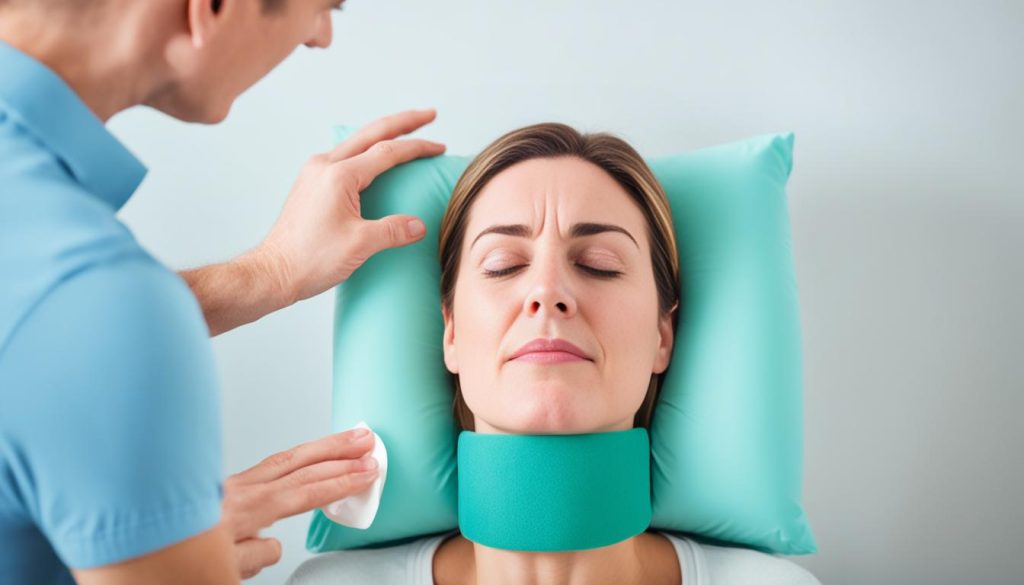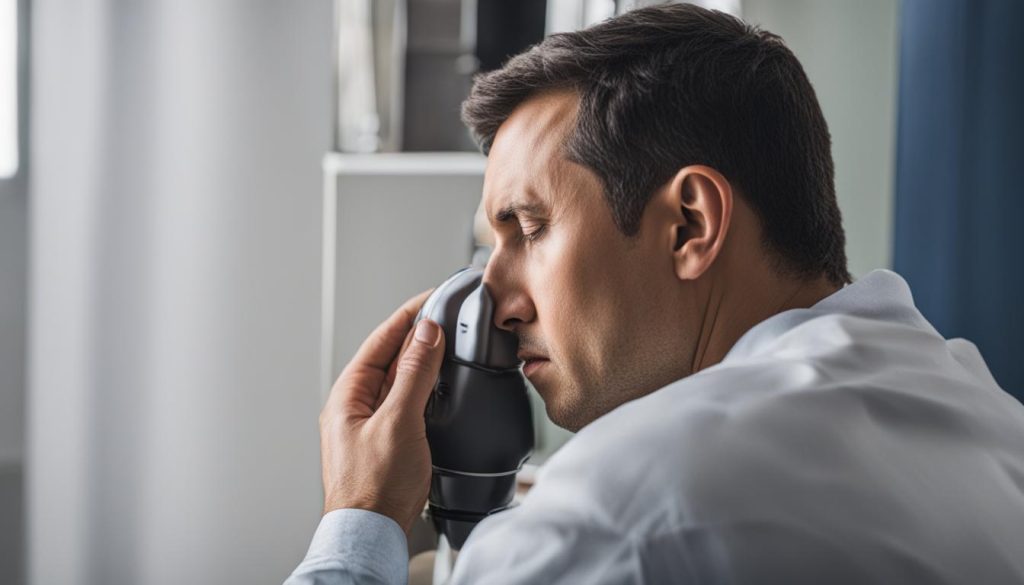Dizziness caused by fluid in the ear can be quite bothersome, but fortunately, there are effective treatments available. If you’re experiencing dizziness due to fluid in your ear, it’s essential to understand the underlying cause and explore appropriate remedies and maneuvers.
One common type of dizziness related to ear fluid is BPPV (benign paroxysmal positional vertigo), which occurs when calcium crystals become dislodged in the inner ear. Fortunately, this type of vertigo is easily treatable, especially in individuals over the age of 60.
To start finding relief from dizziness caused by fluid in the ear, it is important to consult with a healthcare professional. They can provide an accurate diagnosis and guide you toward the most suitable treatment plan.
In the upcoming sections, we will explore various self-treatment maneuvers, exercises, medications, lifestyle changes, and medical treatments that can help alleviate dizziness and improve balance. By following the right strategies and working closely with your healthcare professional, you can effectively manage dizziness caused by fluid in the ear and enjoy a better quality of life.
How to Get Rid of Dizziness From Fluid in Ear?
When experiencing dizziness caused by fluid in the ear, there are effective self-treatment maneuvers that can provide relief. These maneuvers involve specific head and body movements designed to reposition the calcium crystals in the inner ear, alleviating symptoms of dizziness.
Epley Maneuver
The Epley maneuver is a recommended technique for treating dizziness caused by fluid in the ear. It can be performed to alleviate dizziness arising from the right or left ear. By carefully moving the head through a series of positional changes, the Epley maneuver aims to reposition the calcium crystals, providing relief from dizziness.
Here are the steps to perform the Epley maneuver:
- Sit upright on a bed or couch with your legs extended in front of you.
- Turn your head 45 degrees to the right or left, depending on the affected ear.
- Lie down quickly on your back, keeping your head turned to the side.
- Wait for about 30 seconds or until any dizziness subsides.
- Turn your head 90 degrees to the opposite side without raising it.
- Roll onto your side, facing the direction your head is turned. Remain in this position for about 30 seconds.
- Slowly sit up, keeping your head in the same position.
It is important to repeat the Epley maneuver daily until dizziness subsides. However, it is crucial to consult with a healthcare professional before attempting this maneuver to ensure proper execution and determine the affected ear.
Semont Maneuver
The Semont maneuver is another effective self-treatment option for dizziness due to ear fluid. Similar to the Epley maneuver, it can be performed to address dizziness from the left or right ear. By guiding the movement of the head, the Semont maneuver aims to reposition the calcium crystals within the inner ear, providing relief from dizziness.
Here are the steps to perform the Semont maneuver:
- Sit upright on a bed or couch with your legs extended in front of you.
- Quickly lie down on your side, with the affected ear facing upwards.
- Allow your head to hang slightly off the edge of the bed or couch.
- Hold this position for about 30 seconds or until the dizziness subsides.
- Sit upright on the side of the bed or couch, with your legs hanging off the edge.
- Slowly bring your head up to the center, facing forward.
- Move into the opposite lying position, with the affected ear now facing downwards.
- Hold this position for about 30 seconds or until the dizziness subsides.
- Sit up slowly and remain in an upright position.
As with the Epley maneuver, it is important to consult with a healthcare professional before attempting the Semont maneuver to ensure proper execution and to determine the affected ear.
Self-treatment maneuvers such as the Epley and Semont maneuvers can be effective in relieving dizziness caused by fluid in the ear. However, it is essential to consult with a healthcare professional before trying these maneuvers to ensure an accurate diagnosis and appropriate treatment plan.

Exercises to Relieve Dizziness From Ear Fluid
In addition to self-treatment maneuvers, incorporating specific exercises into your routine can help relieve dizziness caused by fluid in the ear. These exercises focus on improving balance and reducing dizziness symptoms. It’s important to perform these exercises regularly and follow the provided instructions to achieve optimal results. However, before starting any exercise regimen, it is crucial to consult with a healthcare professional to ensure safety and effectiveness.
Marching in Place
One effective exercise for relieving dizziness from ear fluid is marching in place. This exercise helps improve coordination, balance, and stability. Follow these steps to perform marching in place:
- Stand with your feet hip-width apart and your arms relaxed at your sides.
- Lift your right knee as high as comfortable while simultaneously swinging your left arm forward.
- Lower your right foot back to the ground and repeat the movement with your left knee and right arm.
- Continue alternating knee lifts and arm swings for a set duration, such as 1 minute, gradually increasing the duration as you build strength and endurance.
Perform marching in place daily to gradually improve balance and alleviate dizziness symptoms.
Turning in Place
Another effective exercise for relieving dizziness from ear fluid is turning in place. This exercise helps improve vestibular function and reduces dizziness episodes. Follow these steps to perform turning in place:
- Stand with your feet shoulder-width apart and your arms relaxed at your sides.
- Keeping your feet planted, slowly turn your entire body to the left as far as comfortable, focusing on a fixed point in the room.
- Hold the turned position for a few seconds, maintaining your gaze on the fixed point.
- Gradually turn your body back to the center and repeat the movement to the right.
- Continue alternating turning left and right for a set duration, such as 1 minute, gradually increasing the duration as you build balance and stability.
Perform turning in place daily to enhance vestibular function and reduce dizziness symptoms caused by ear fluid.

Medications for Dizziness From Ear Fluid
In some cases, medications may be prescribed to help manage dizziness caused by fluid in the ear. These medications target the underlying causes of dizziness and aim to alleviate symptoms, providing relief and improving balance.
Water Pills (Diuretics)
Water pills, also known as diuretics, are commonly used to reduce fluid buildup in the inner ear. These medications help decrease the amount of fluid in the body, including the inner ear. By reducing fluid volume, water pills can help alleviate dizziness caused by ear fluid. They are particularly effective in managing conditions like Meniere’s disease, which involve excessive fluid accumulation in the inner ear.
Anti-Anxiety Medications
In some cases, dizziness from inner ear fluid may be exacerbated by anxiety or stress. In these situations, healthcare professionals may prescribe anti-anxiety medications to calm the nervous system and alleviate dizziness symptoms. These medications can help manage the psychological component of dizziness, reducing the overall impact on balance.
Preventive Migraine Medication
Migraines can sometimes trigger dizziness and disrupt the balance mechanism in the inner ear. Preventive migraine medication may be prescribed to reduce the frequency and severity of migraines, subsequently reducing dizziness episodes. By addressing the underlying migraine condition, these medications can provide significant relief from dizziness caused by ear fluid.
It is important to consult with a healthcare professional to determine the appropriate medication and dosage for individual cases. They can diagnose the root cause of dizziness, assess the severity of symptoms, and tailor medication recommendations to address specific needs.

Lifestyle Changes for Dizziness From Ear Fluid
Making certain lifestyle changes can help alleviate and manage dizziness caused by fluid in the ear. By implementing these changes, individuals can find relief and improve their overall balance. It is important to consult with a healthcare professional for personalized recommendations based on individual circumstances.
Avoid Triggers
- Avoid consuming caffeine, as it can worsen dizziness symptoms.
- Limit alcohol intake, as it can affect balance and increase dizziness.
- Reduce salt intake, as excessive sodium can contribute to fluid retention and worsen ear congestion.
- Avoid tobacco or secondhand smoke, as they can irritate the nasal passages and exacerbate dizziness.
Maintain a Healthy Diet
Eating a balanced diet is essential for managing dizziness caused by fluid in the ear. Incorporate the following foods into your meals:
- Fresh fruits and vegetables
- Whole grains
- Lean proteins
- Healthy fats, such as avocados and nuts
Stay Hydrated
Proper hydration is important for overall health and can help alleviate dizziness. Drink an adequate amount of water throughout the day to maintain hydration levels. Avoid excessive consumption of sugary or caffeinated beverages, as they can contribute to dehydration and worsen dizziness symptoms.
Practice Stress-Reducing Techniques
Stress and anxiety can exacerbate dizziness symptoms. Implement stress-reducing techniques such as deep breathing exercises, meditation, or yoga to promote relaxation and alleviate dizziness due to ear fluid.
Get Enough Sleep
Adequate sleep is crucial for maintaining overall well-being, including balance. Ensure you get enough sleep each night to support your body’s natural healing processes and reduce the frequency of dizziness episodes.
Avoid Sudden Movements
Rapid movements or changes in position can trigger dizziness. Take your time when transitioning from lying down to standing up or from sitting to standing, allowing your body to adjust gradually and minimize the risk of dizziness.

Diagnostic Procedures for Dizziness From Ear Fluid
Accurate diagnosis is crucial for effective treatment of dizziness caused by fluid in the ear. To determine the underlying cause of dizziness and identify the affected ear, healthcare professionals may use a variety of diagnostic procedures. These procedures help provide valuable insights into the condition and guide appropriate treatment plans.
Physical Examination
A physical examination is usually the first step in diagnosing dizziness from ear fluid. During the examination, the healthcare professional will evaluate the patient’s overall health and perform specific tests to assess balance, coordination, and reflexes.
Symptom and Medication Review
A review of the patient’s symptoms and medications is essential for diagnosing dizziness caused by fluid in the ear. By discussing the nature of the dizziness episodes, their frequency, and any accompanying symptoms, healthcare professionals can gather valuable information to narrow down the potential causes.
Eye Movement Testing
Eye movement testing, such as the electronystagmography (ENG) or videonystagmography (VNG), may be conducted to assess the patient’s eye movements. These tests can help determine if certain eye movements present abnormalities that are indicative of an inner ear disorder.
Head Movement Testing
Head movement testing, such as the Dix-Hallpike test or the Head Thrust Test, can help determine the presence of benign paroxysmal positional vertigo (BPPV). By carefully observing the patient’s response to specific head movements, healthcare professionals can identify whether the crystals in the inner ear are causing dizziness.
Balance Tests
Balance tests, such as the Romberg test or the Dynamic Visual Acuity test, evaluate the patient’s ability to maintain balance and stabilize vision. These tests assess the functioning of the vestibular system and can provide valuable information about the extent and severity of dizziness symptoms.
Blood Tests and Imaging Scans
In some cases, additional blood tests or imaging scans, such as MRI or CT scans, may be ordered to rule out other medical conditions that could be contributing to dizziness symptoms. These tests help ensure a comprehensive evaluation and accurate diagnosis.
Consulting with a healthcare professional is essential to undergo the appropriate diagnostic procedures and receive an accurate diagnosis for dizziness caused by fluid in the ear.
| Diagnostic Procedures for Dizziness From Ear Fluid | Key Features |
|---|---|
| Physical Examination | Evaluates overall health and assesses balance, coordination, and reflexes. |
| Symptom and Medication Review | Gathers information about the nature of dizziness episodes and medications that may contribute to the symptoms. |
| Eye Movement Testing | Assesses eye movements to identify abnormalities indicative of inner ear disorders. |
| Head Movement Testing | Evaluates the response to specific head movements to determine the presence of BPPV. |
| Balance Tests | Assesses balance and visual stabilization to evaluate the functioning of the vestibular system. |
| Blood Tests and Imaging Scans | Helps rule out other medical conditions and provide a comprehensive evaluation. |
Medical Treatments for Dizziness From Ear Fluid
In some cases, medical treatments may be necessary to manage dizziness caused by fluid in the ear. These treatments can include medications such as water pills, antihistamines, and anti-anxiety medications. Injections of antibiotics may be used to disable the balance function in the inner ear. In rare cases, surgical procedures like labyrinthectomy may be considered to address severe dizziness that hasn’t responded to other treatments. The specific treatment approach will depend on the underlying cause and severity of symptoms.
When it comes to medical treatments for dizziness from ear fluid, several options are available. Medications, such as water pills, antihistamines, and anti-anxiety medications, can help alleviate symptoms. Water pills, also known as diuretics, can reduce fluid buildup in the inner ear, while antihistamines can help control dizziness related to allergies. Anti-anxiety medications may be prescribed to manage the emotional aspects of dizziness.
In some cases, injections of antibiotics may be used to disable the balance function in the inner ear. This procedure, known as intratympanic gentamicin injection, is typically reserved for severe cases of dizziness that do not respond to other treatments. By disrupting the balance function, the injections can help stabilize symptoms and provide relief.
In rare situations where all other treatment options have failed, a surgical procedure called labyrinthectomy may be considered. This procedure involves removing the inner ear structures responsible for balance. While it can effectively eliminate dizziness, it also causes permanent hearing loss in the affected ear.
It is important to note that the specific treatment approach will depend on the underlying cause and severity of the dizziness. A healthcare professional will thoroughly evaluate the individual case and determine the most suitable treatment plan. Consulting with a medical specialist is essential to ensure proper diagnosis, individualized treatment, and monitoring of progress.
Conclusion
Dizziness caused by fluid in the ear can be effectively managed through various treatment approaches. Self-treatment maneuvers, such as the Epley and Semont maneuvers, can help reposition the calcium crystals and provide relief from dizziness. Additionally, specific exercises, such as marching in place and turning in place, can improve balance and reduce symptoms. Medications, such as water pills and anti-anxiety drugs, may be prescribed to address fluid buildup and alleviate dizziness.
Lifestyle changes, including avoiding triggers like caffeine and alcohol, can also contribute to managing dizziness from ear fluid. Making these adjustments, along with practicing stress-reducing techniques and maintaining a healthy diet, can help minimize symptoms. In some cases, medical treatments, such as injections or surgical procedures, may be necessary to address severe and persistent dizziness.
It is crucial to consult with a healthcare professional for an accurate diagnosis and personalized treatment plan. Regular follow-up appointments and communication with your doctor are essential for monitoring progress and adjusting your treatment as needed. By addressing the underlying cause of dizziness and implementing appropriate treatment recommendations, you can experience relief from symptoms and improved balance.




